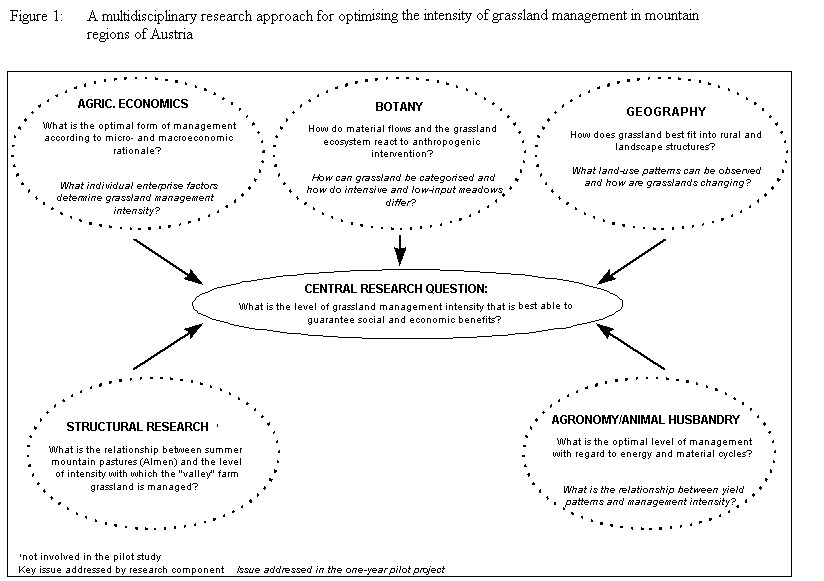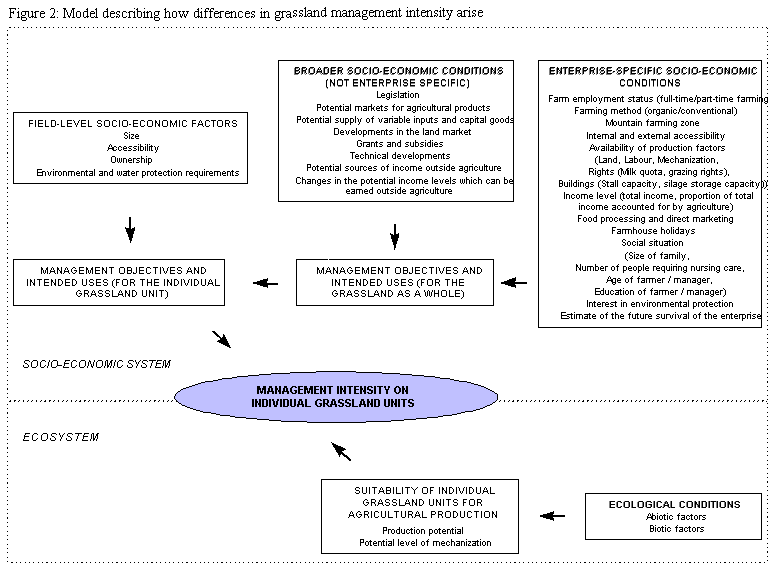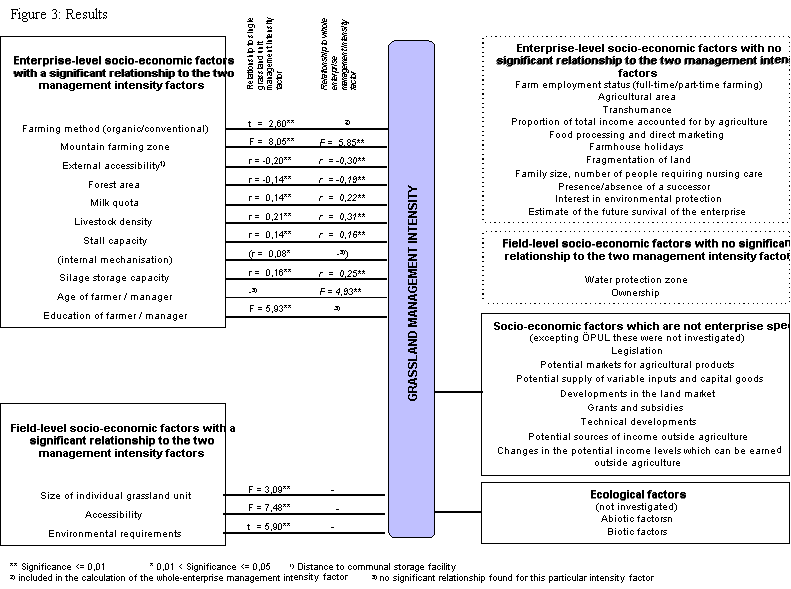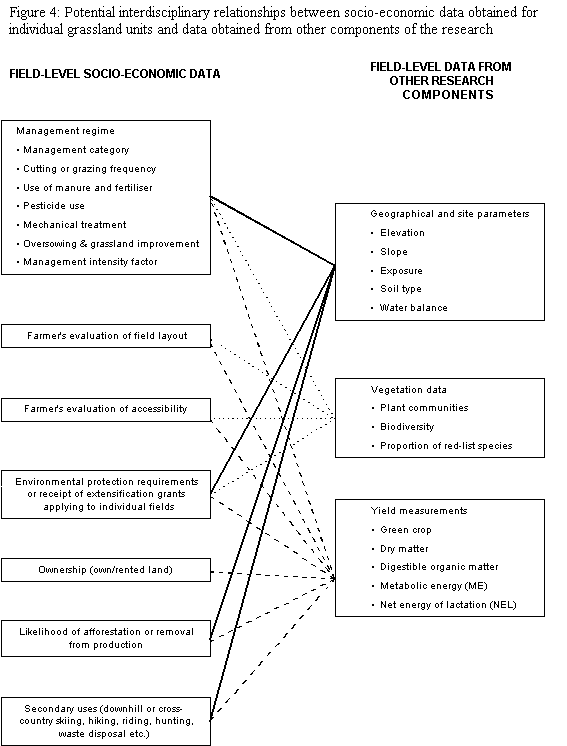 The James Hutton Institute
The James Hutton Institute
This page is no longer updated. The Macaulay Land Use Research Institute joined forces with SCRI on 1 April 2011 to create The James Hutton Institute.
2nd LSIRD Conference on Livestock production in the European LFAs, Bray, Ireland. Dec '98
A MULTIDISCIPLINARY FRAMEWORK FOR OPTIMISING THE INTENSITY OF GRASSLAND MANAGEMENT IN MOUNTAIN REGIONS OF AUSTRIA
C. Mayer and H.K. Wytrzens
1. INTRODUCTION
Thanks to the alpine nature of the country, a large proportion of Austria's farms are found in disadvantaged mountain regions. Grassland is a key component of the traditional cultural landscape in these areas as it accounts for around a third of all land use (BMLF 1998, 66 and 209). Therefore changes in the way meadows and pastures are managed have far-reaching effects on the landscape. In this context, we are currently witnessing a trend towards polarisation, where grassland management is becoming more intensive in some areas and less intensive in others. Intensification has negative implications for the environment, while extensification may go as far as converting the land to an alternative land use such as forestry, or taking it out of production all together. Given that grassland fulfils a variety of agricultural, socio-economic and ecological functions (WYTRZENS 1995, 90ff; BRIEMLE and ELSÄSSER 1997, 273ff), the consequences of such developments from the point of view of society (e.g. reductions in biodiversity or loss of a recreational resource) can certainly be considered undesirable.
The ongoing project "Landscape and Agriculture in Transition: Grassland in the Mountain Regions of Austria" was set up against this background of changing land-use practices. The research is part of the UNESCO Man and Biosphere Programme and deals with the core issue of optimal management intensities for grassland in Austria's mountains.
This paper first outlines the multidisciplinary approach taken in the project and then describes the socio-economic research component and its place in such a pluralistic research design. We then introduce an explanatory model which seeks to describe the relationships between socio-economic and environmental factors and management intensity. A one year pilot study has already been carried out in Central Ennstal (Styria) and the initial empirical results from the socio-economic component are also presented. Finally, I discuss the practical experiences obtained to date and report on some of the opportunities and problems associated with co-operation across research disciplines.
2. THE MULTIDISCIPLINARY RESEARCH APPROACH
Given that both socio-economic and ecological principles play a role in grassland management, research on the subject has to follow a multidisciplinary approach. Experience has shown that such approaches work best when all research participants work towards a clearly defined set of common goals (ISERMEYER 1996, 5f). All members of the research team involved in the work presented here have committed themselves to the following objectives:
As mentioned in the introduction, a detailed case study was carried out as a pilot project in Central Ennstal (Styria). The intention was to provide some initial insights into the factors underlying differences in the intensity of grassland management. This pilot analysis addressed the complex of interactions involving social factors, economic rationale, process-based decisions, production potential and ecological components. The disciplines involved in both the pilot and main projects, together with the key research topics tackled within each discipline are given in Figure 1.
Initial work concentrated on finding interdependencies between the following factors:
The aim was to find these interdependencies from the perspective of as many different specialisms as possible and for each type of grassland management. In order to help guarantee a truly multidisciplinary approach, a common framework of test parcels was used, i.e. all project scientists had to focus on the same research units, irrespective of research discipline. These individually delineated units provided therefore a central interface where data from different strands of the research could be integrated.
Since the results from the different research components are still being drawn together, the remainder of this paper restricts itself to the socio-economic research component and the empirical results obtained to date.

3. THE SOCIO-ECONOMICS OF DIFFERENT GRASSLAND MANAGEMENT INTENSITIES
3.1 The Socio-economic Research Approach
In order to ensure its compatibility with the broader research agenda, the socio-economic research sought to identify and test a model which would explain the emergence of different levels of grassland management intensity. After all, the identification of those factors responsible for the appearance of different management intensities (or which at least impose some form of pressure on alpine grassland management) must precede any realistic attempt to optimise these management intensities.
The model concepts presented treat grassland management as the net outcome of a range of multilayered and interconnected social and economic forces and ecological influences.
Before constructing any form of model it was of course necessary to define both "management intensity" and the means by which it could be quantified. We can use two definitions:
The model illustrated in Figure 2 refers primarily to the second definition of management intensity. This model is based on the idea that socio-economic and ecological factors (and the complex interactions between the two) are responsible for the differences in grassland management intensities (MAYER and WYTRZENS 1998; PISTRICH 1998).
Ecological factors can only be partly influenced by human intervention and include both abiotic site conditions (climate, topography, soil) and the biotic elements of the grassland ecosystem (KLAPP 1971; OPITZ VON BOBERFELD 1994). Socio-economic factors can be split into two groups. One group contains those factors that remain constant across an enterprise or a group of enterprises, for example family size or the proportion of land taken up by forestry. The factors in the second group are those that can vary between different parcels of land and which determine the production potential of individual grassland units. The research identified 30 potential factors of relevance to management intensity, whereby the presence or absence of these factors and their importance varies on a case-to-case basis. Taking these factors into account, the model gives the following broad explanation for the existence of a particular grassland management intensity: The farmer or farming family has special intentions and objectives regarding the use and management of the grassland on their enterprise. The decisions made in this regard are dependent on the broader conditions in which the farm operates and on enterprise-specific characteristics. These overlying objectives, together with

the local socio-economic conditions prevailing on each grassland unit, then determine the intended uses and management objectives for each individual unit of land. Their actual implementation is however constrained by the degree to which each of these land units is suited to agricultural production. This suitability is itself expressed though the unit's yield capacity and its potential level of mechanization; these are themselves determined by ecological factors (see also SCHEURER-LIETZ 1989, 20ff).
3.2 Methodology Behind the Empirical Socio-economic Analysis
The proposed model was tested empirically using the results of an Autumn 1997 survey of 125 farmers. This survey gathered detailed information on the current management of 377 pasture and meadow units, social and enterprise characteristics, and aspects of production technology.
A precise quantification of the labour and capital input on individual units of land turned out to be impossible. Therefore, the following "intensity parameters" were used to represent the level of management intensity on any one unit of land:
n = number of cuts + number of grazings * 0,67 + follow-up grazing * 0,335;
In a first step, each intensity parameter was tested independently for any correlation with field-level or enterprise-level socio-economic characteristics, i.e. the hypotheses regarding the importance of selected economic and social factors were tested using ANOVA and the t-test. Net management intensity was evaluated through a "field-level management intensity factor" (bi):
bi = 2 * + 2 * + 2* + + +
This intensity factor is the sum of the standardised numeric expressions (hence the Greek letters) of each of the intensity parameters listed above. "Cutting and grazing frequency" and "amount of nitrogen applied each year" were weighted with a factor of 2 because they are particularly important in determining the quality and quantity of the yield. The "number of mechanical treatments" was given a similar weighting. This is because this variable covers a wide range of potential treatments (rolling, mechanical weed control etc.); the weighting compensates for the fact that pesticide use, oversowing and grassland improvement are treated separately and are, by implication, given a higher weighting than any of the other individual mechanical treatments covered under parameter p.
If the mean level of management intensity across the whole enterprise is known, then this allows comparisons between different enterprises. The parameters used in calculating this "enterprise-level management intensity factor" (BI) are:
0 = no artificial fertilisers or pesticides used anywhere on the enterprise [as part of the Austrian Agriculture and Environment Programme (includes organic farms)];
0,5 = no artificial fertilisers or pesticides5 used on some parts of the grassland area [as part of the Austrian Agriculture and Environment Programme]
1 = no reduction in use of artificial fertilisers or pesticides on any part of the enterprise [as part of the Austrian Agriculture and Environment Programme]
BI is the sum of these two parameters:
BI = a + b
There was no need to standardise these two variables since they can both only take values between 0 and 1.
It is now possible to describe the relationships between the two intensity factors and the various field-level and enterprise-level socio-economic factors.
3.3 Main Socio-economic Results
With respect to the field-level socio-economic factors, significant relationships were found between bi and grassland unit size, accessibility and environmental protection requirements. Relatively small (< 1 ha) or inaccessible management units, for example, tend to be managed less intensively. The input of labour and capital to grassland units subject to some form of environmental protection is also well below average. In contrast, ownership and whether the land is in a declared water protection area or not seem to have no significant impact on management intensity.
Significant relationships between the two intensity factors and enterprise-level socio-economic factors are given in Figure 3. In general the relationships with the whole-enterprise management intensity factor are stronger. This is because there is usually a wide variation in the use of production factors within a single enterprise, dependent on the particular conditions prevailing on each pasture or meadow unit. Nevertheless, the effects of a whole range of enterprise factors on individual grassland units can still be observed, albeit to a lesser extent.
There is a comparatively strong relationship between the two management intensity factors and mountain farming zone. The intensity factors on grassland units from farms in zones 3 and 4 are well below average. Since zone classification is partly based on abiotic site factors such as slope and elevation, this result would seem to suggest that such factors are likely to be of considerable importance. The accessibility of the enterprise, which is also used in zone classification, was analysed separately in this research; there was also a strong significant relationship between this factor and the levels of management intensity, as there was for farming methods (organic/conventional) and forest area.
The education of the farmer also proved to be a key determinant behind the level of management inputs applied to a grassland unit. On average, enterprises run by farmers with no agricultural training have the lowest intensity factors.
There appears to be a two-way relationship between management intensity and milk quota, stall capacity, silage storage capacity and inside mechanisation. While higher values for these factors do encourage more intensive land management, the factors themselves are also likely to be dependent on the intensity with which the grassland is used. The same applies to livestock density, which is also significantly correlated with both management intensity factors.
The age of the farmer / manager is significantly correlated with the whole enterprise management intensity factor and also seems to influence the readiness to participate in various extensification schemes proposed under ÖPUL, the Austrian Agriculture and Environment programme. The willingness to give up the use of yield-boosting inputs such as pesticides, or to convert to organic agriculture, falls with increasing age.
A large number of enterprise-level socio-economic factors, including farm employment status, proportion of total income accounted for by agriculture and amount of agricultural land, showed no correlation with either of the two management intensity factors. The presence or absence of particular business activities such as food processing and direct marketing or farmhouse holidays also has no significant influence on management intensities. This may be due to the traditional allocation of responsibilities in the farming household; women tend to do most of the work associated with renting out accommodation (CLAUPEIN 1991, 54ff), for example, while men are generally responsible for managing the grassland. There was also no correlation between management intensities and particular social factors (family size, number

of people requiring nursing care, line of succession) or with the estimate of the future survival of the enterprise.
A few factors, such as ownership, are significantly correlated with individual intensity parameters, but not with the net intensity factors. There is no significant relationship between the whole enterprise management intensity factor and the farmer's interest in environmental protection. Nevertheless, those farmers who did express a strong interest in environmental protection are significantly more likely to use no artificial inputs such as fertilisers and pesticides on their enterprises (whether as part of ÖPUL or following conversion to organic agriculture). Other farmers with less of an interest in environmental protection tend to apply such restrictions only to selected parts of their enterprises.
The Austrian agri-environmental programme "ÖPUL" has been a key determinant of grassland management intensity in recent years, since it includes a range of measures which restrict the use of artificial fertilisers and pesticides or which lower livestock numbers. ÖPUL was widely accepted by the farmers in the survey; only two enterprises do not participate in the programme. The most common programme elements found on the farms are the basic subsidy scheme (121 enterprises), mowing in steep and mountainous areas (78 enterprises), and an agreement not to use artificial fertilisers or pesticides on a special percentage of their grassland (53 enterprises). 25 enterprises have given up the use of artificial fertilisers and pesticides completely, and a further 34 farm are run organically; these enterprises tend to be found in the more disadvantaged mountain regions. In 25 cases, farmers cited ÖPUL as the main reason behind a general reduction in fertiliser use on their enterprises, which shows that ÖPUL really is helping to encourage environmentally sensitive forms of agriculture. In addition to ÖPUL, farmers also gave the following reasons for changes in grassland management intensity (in terms of fertiliser treatment, frequency of cutting and grazing, and general maintenance measures):
It was not possible to test the influence on management intensities of those socio-economic factors which are related to the broader environment in which grassland enterprises operate. The pilot project was focused on a relatively small geographical area, so the variation in these factors was insufficient to allow any form of correlation analysis.
3.4 Discussion of the Socio-economic Results and Conclusions
The results of this pilot study need to be treated with caution since the survey was not statistically representative. Nevertheless, the results do appear to identify some basic trends (for example the major role played by parcel size and field accessibility in determining management intensity).
Furthermore in the pilot study we managed to get a reasonable measurement of management intensity at the level of individual grassland units. The whole enterprise management intensity factors obtained can, however, only be considered very rough estimates, and the precision and accuracy of this particular measure needs to be improved in subsequent work.
Although the value and relevance of the results obtained should not be overestimated, they do allow us to draw some conclusions with regard to political policy measures:
The results confirm that grassland in favoured agricultural areas tends to be managed more intensively than grassland in more disadvantaged areas. Very few of the enterprises surveyed had actually afforested or abandoned their more marginal grassland units within the last five years. Nevertheless, these kinds of undesirable land-use changes might well become more common if there are further reductions in agricultural prices. Together with the broader transformation of agricultural structures currently taking place, this could lead to the long-term loss of agricultural land and may even make it impossible to maintain the traditional "all-encompassing" nature of agricultural management in alpine areas. This threat - provided it is actually perceived as such by the population at large - could be counterbalanced through measures aimed at increasing the mobility of land ownership. This might provide sufficient incentive to keep those grassland areas which are threatened by abandonment under active management.
Infrastructural and land improvement projects could help prevent grassland from being converted to alternative land uses or taken out of production in the first place. Should such measures not achieve the desired results and the farmers show no interest in continuing to farm particularly uneconomical and unproductive parcels of land, then efficient incentives for carrying out some kind of minimal grassland management need to be created (assuming of course that society sees the preservation of grassland as an issue of importance).
The results do confirm that the Austrian Agriculture and Environment Programme (ÖPUL) plays a key role in encouraging and preserving environmentally sensitive grassland management in mountain areas. The future survival of those pastures and meadows that are managed on a less intensive basis (i.e. the kind of land use which environmentalists value so highly) looks certain to depend on the continuing supply of government funds and, in the long term, appropriate support from society. It would seem sensible to try and make the general population more aware of the various socio-economic and environmental roles played by grassland. This would have the positive side-effect of allowing those agricultural support payments which arise through the Agriculture and Environment Programme to be presented as compensation for ecological services rather than as simple subsidies. However, if the internalisation of the positive external effects of grassland management through performance-based payments is to develop further, then scientists and politicians need to be able to define these ecological and socio-economic services more closely. They also need to find methods for adequately measuring the extent to which these services are carried out by farmers.
4. INTEGRATION OF THE SOCIO-ECONOMIC APPROACH IN THE MAIN PROJECT
The new challenges faced by researchers and politicians can only be mastered through multidisciplinary approaches. Existing knowledge and data need to be brought together within a network that recognises no disciplinary boundaries.
Even in its first pilot year, the current project allowed for integration of economic, technological, yield and plant ecology data (with, as mentioned earlier in the paper, the single grassland plot acting as a common reference point). The socio-economic research component has contributed data covering the enterprise as a whole (e.g. animal numbers, degree of participation in agricultural support programmes, mountain zone etc.) as well as information concerning management regimes on, or non-agricultural uses of, selected grassland units. The ways in which socio-economic data relating to individual grassland units might be linked to data arising from research undertaken in the natural and technical sciences are illustrated in Figure 4. This figure reflects the framework of hypotheses constructed specifically for the multidisciplinary analysis. Although attempts to link all the available data have begun, the final results are not yet available. Preliminary results have, however, made it clear that too many variables were surveyed in the pilot phase. Given the time and effort required for data collection in the pilot project, it would be impractical to scale the project up in terms of geography and content, as originally planned. The set of variables covered in the research must first be trimmed to include just those which are key determinants and relatively easy to survey.
In addition to pruning the set of variables under analysis down to a manageable level, the socio-economic component of the project is currently tackling, or will be tackling, the following tasks in order to be able to make further contributions to the ultimate goal of the project - the optimisation of grassland management intensities:

The aim is to capture the complex social, political and economic relationships involved in the optimisation of grassland management within a model in such a way that they can easily be combined with other ecological, technical and rural planning model elements. The result should be a single model capable of delivering sound ecological, technical and socio-economic information on which to base decisions concerning sustainable grassland management.
5. CONCLUSIONS REGARDING MULTIDISCIPLINARY RESEARCH
Although the planned exchange and integration of data from different components of the pilot project has yet to be completed, some clear conclusions regarding the opportunities and problems associated with a multidisciplinary research approach can still be made:
In summary, there is considerable potential for conflict in the kind of multidisciplinary project represented by the "Landscape and Agriculture in Transition: Grassland in the Austrian Alps" project. Its success depends on proper organisation and co-ordination of research activities, theoretical and methodological innovation and a willingness on the part of all participants to communicate with each other.
Summary
This paper introduces the MAB-project "Landscape and Agriculture in Transition: Grassland in the Mountain Areas of Austria ", which deals with the optimisation of grassland management in disadvantaged mountain regions. The project is due to continue over a period of four years and attempts to reflect the complexity of the core subject "grassland" through a multidisciplinary research approach, which is described in this paper. The construction of a theoretical explanatory model and initial empirical results from the socio-economic component of the research are presented. This particular research component seeks to identify those factors influencing the level of intensity of grassland management, by analysing the effects of selected field-level and enterprise-level socio-economic measures on the use of production factors in grassland management. This study uses information gathered in a survey of farm managers in Central Ennstal, Styria.
The innovative potential of the research approach is seen in the range of ways in which data from the socio-economic research component presented here can be combined with data from botanical and production-orientated project teams. Although the interdisciplinary analysis is still in progress, it is clear that such a complex, multidisciplinary approach carries with it a range of new opportunities and problems. Its success depends on proper organisation and co-ordination of research activities and a willingness on the part of all participants to communicate with each other.
References
BMLF BUNDESMINISTERIUM F&UUML;R LAND- UND FORSTWIRTSCHAFT (1998): Bericht über die Lage der österreichischen Landwirtschaft 1997. Vienna: Herold Verlag.
BRIEMLE, G. and ELS&AUML;SSER, M. (1997): Die Funktionen des Grünlandes. In: Berichte über die Landwirtschaft. Volume 75/1997.
ISERMEYER, F. (1996): Organisation von interdisziplinären Forschungsverbünden in der Agrarforschung. Arbeitsbericht 1/96 des Instituts für Betriebswirtschaft der Bundesforschungsanstalt für Landwirtschaft Braunschweig-Völkenrode.
KLAPP, E. (1971): Wiesen und Weiden. Eine Grünlandlehre. 4th Edition., Berlin and Hamburg. Verlag Paul Parey.
OPITZ VON BOBERFELD, W. (1994): Grünlandlehre. Biologische und ökologische Grundlagen. Stuttgart: Verlag Eugen Ulmer.
PISTRICH, K. H. (1998): Einzelflächenbezogene Intensitätsunterschiede der Grünlandnutzung und -bewirtschaftung. Vienna: Diplomarbeit, Universität für Bodenkultur.
REISCH, E. and ZEDDIES, J. (1983): Einführung in die landwirtschaftliche Betriebslehre. Volume 2, 2nd Edition, Stuttgart: Verlag Eugen Ulmer.
SCHEURER-LIETZ, T. (1989): Die Verfügbarkeit landwirtschaftlicher Ressourcen im Berggebiet. Konzeption und Anwendung landwirtschaftlicher Nutzungsszenarien (Testgebiet Grindelwald). Final report of the Swiss MAB-Programm Nr. 38/1989 within the UNESCO Programme "MAN AND BIOSPHERE". Bern.
WYTRZENS, H. K. (1995): Grünland als Element der Agrarraumgestaltung.
In: VERBAND DEUTSCHER LANDWIRTSCHAFTLICHER UNTERSUCHUNGS- UND FORSCHUNGSANSTALTEN
(VDLUFA) (Editor): Kongreßband 1995 Garmisch-Patenkirchen. Vorträge
zum Generalthema des 107. VDLUFA-Kongresses vom 18. - 23.9.1994 in Garmisch-Patenkirchen.
Grünland als Produktionsstandort und Landschaftselement und weitere
Beiträge aus den Sitzungen der Fachgruppen. Darmstadt: VDLUFA-Verlag.
WYTRZENS, H. K. and MAYER, CH. (1998): Unterschiedliche Nutzungs- und
Bewirtschaftungsintensitäten im Grünland des Mittleren Ennstales
und ihr sozioökonomischer Hintergrund. Forschungsbericht der Arbeitsgruppe
für Regionalplanung am Institut für Agrarökonomik der Universität
für Bodenkultur, Volume 3. Vienna.